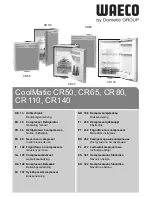
11
4 MAINTENANCE OF REFRIGERATOR
4.1 Cleaning
4.2 Defrost
4.3 Stop Using
• Clean dust behind the refrigerator and on the ground to improve the cooling effect and
energy saving.
• Check the door gasket regularly to make sure there is no debris. Clean the door gasket
with a soft cloth dampened with soapy water or diluted detergent.
• Clean the interior of the refrigerator regularly to avoid odor.
• Please turn off the power before cleaning interior, remove all food, shelves, drawers, etc.
• Use a soft cloth or sponge to clean the inside of the refrigerator, with two tablespoons
of baking soda and a quart of warm water. Then rinse with water and wipe clean. After
cleaning, open the door and let it dry naturally before turning on the power.
• For areas that are difficult to clean (such as narrow gaps or corners), it is recommended
to wipe them regularly with a soft rag, soft brush, etc. to ensure no contaminants or
bacteria accumulate in these areas.
• Do not use soap, detergent, scrub powder, spray cleaner, etc., as these may cause odors in
the interior of the refrigerator or contaminate food.
• Clean the bottle frame, shelves and drawers with a soft cloth dampened with soapy water
or diluted detergent. Dry with a soft cloth or dry naturally.
• Wipe the outer surface of the refrigerator with a soft cloth dampened with soapy water,
detergent, etc., and then wipe dry.
• Do not use hard brushes, clean steel balls, wire brushes, abrasives (such as toothpastes),
organic solvents (such as alcohol, acetone, banana oil, etc.), boiling water, acid or alkaline
items, which may damage the cooler surface and interior. Boiling water and organic
solvents such as benzene may deform or damage plastic parts.
• Do not rinse directly with water or other liquids during cleaning to avoid short circuits or
damage to the electrical insulation.
• Power off the refrigerator and disconnect the plug from the wall socket. Open the door
and remove all the food to a cool place. Clean the drain pipe, paying special attention to
cleaning the compressor compartment water draining tray to avoid water overflowing
onto the ground. It is recommended to remove the frost by a plastic scraper, or let the
temperature rise naturally until the frost melts. Then wipe away the remaining ice and
water, and plug in the refrigerator. After defrosting, put all food back into the refrigerator,
and power on.
Power failure: Food can usually be preserved for a couple of hours in case of power failure.
It is recommended to reduce the frequency of opening the door and to not put fresh food into
the refrigerator.
Long-time nonuse: Please unplug unused refrigerator for cleaning. Keep the door open to
avoid odor.
Moving: Do not turn upside or shake the refrigerator, the carrying angle can not be greater
than 45°.
Do not hold the door and hinge when moving this unit.
Continuous operation is recommended when the refrigerator is started.
To prevent affecting the refrigerator’s service life, please do not stop the
refrigerator under normal circumstances.
Summary of Contents for H16MRB
Page 15: ...13 ...


































